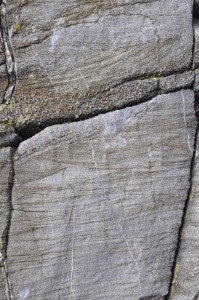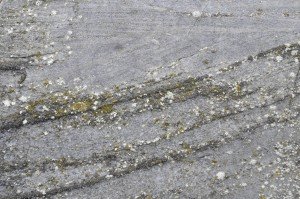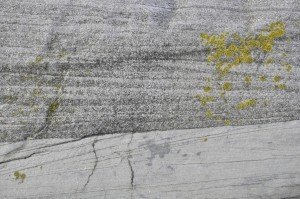OK, folks, here is another post of Early Paleozoic sediments from Hovedøya, near Oslo. Because that’s the closest to my home I find pretty sedimentary rocks. This time, the I will teach you some sedimentology as well. There is an exam question at the end of the post, to ensure you read it all.
You have a rock composed of old sand. How do you find out if that sand was deposited in a river, a or a delta, or which way the flow went? You look at the crossbeds. Do they all point in the same direction, or go back and forth?
Hey! What is a crossbed? And, heck, who cares, as long as there is oil in the sand?
Well, the short answer is that understanding the sand may help you find out if is possible to pump the oil up.
Think about a river and its shape. It is a band of water, wide or narrow, that floats through the landscape. It carries sand, possibly some gravel if it floats fast, and deposits the sand off in the inner curves of bends and meanders, because the water flows slower there. Outside the river is mostly mud, no good for reservoir.
Luckily, changing ways is a common habit of rivers, and some rivers are several kilometers wide. They will cast out thin, but wide sand sheets, and as the river path changes, these sheets will partly eat into each other. Voila, a huge blanket of sheets in communication with each other. Big volume, ready to produce.
Deltas are different. They form where the river flow suddenly halts, crashing into the large water body called the sea. The lost energy means the water can no longer carry the heavy sand, and it is deposited, while fine mud particles are carried further out into the sea. Deltas build out into the sea as they add more and more mass at the river mouth, and this sand is further reworked by the sea waves, sorting out any fine mud. Therefore, deltas can be essentially big chunks of sand, the best reservoir a gologist can get.
Nice, nice, but you still haven’t said anything about those elusive «crossbeds» and why I should care?

Crossbeds going back and forth, likely reflecting wave movements. The coarse bed may be due to a flood in the river that supplies sediments to the shore, or a storm ripping up coarse material.
OK, nagging reader, I’ll tell you what a crossbed is: When water flows and brings sand with it, each time the water reaches a minor obstacle and is slightly slowed down, some sand is dropped from suspension and settler on the water floor. That very sand will create a new minor obstacle, which halts the flow a little, and new sand will therefore drop out downwards. Thus, the sand at the bottom of the flow will form a looong series of gently dipping, tiny surfaces after each other. Depending on the grain size of sand and the water energy, crossbeds can be very gentle, or steeper. The process is essentially the same that forms sand dunes in deserts; wind carries sand along, up sand dunes as well, but on the lee side, the sand settles. In fact, the biggest crossbeds are those formed in sand dunes.
In a river, there will be an ever-lasting supply of sand following the current. The current may vary in strength, sometimes being too low to carry sand, sometimes so strong that it just erodes into the sand deposited previously – otherwise the volume in the river, the “accommodation space”, would be filled in no time. So, crossbeds get their name from the x pattern formed by the gentle surfaces in deposited sand beds, and the flatter erosion surfaces in between those beds. Since rivers float only one way – downwards – all crossbeds will fall in the same direction. Conversely; if all your crossbeds fall in the same direction, they likely formed in a river.
On the tip of deltas, however, two other forces come to action: Waves and tides.
Waves sometimes come from a predominant direction, sometimes from various directions, interrupted by storms. Consequently crossbeds from waves may have a quite uniform direction, but more typically are messy, resulting from changing direction and intensity. Importantly, the high energy in the waves sort out the finer material, leaving only sand left, and close to shore deposits are therefore some of the best reservoirs.
Tides, eternally going back and forth, predictable like a commuter train, creates thin, regular beds, with oppositely verging crossbeds. One in, one out, one in, one out…often with thin mud deposits in between, during the still when tides change.
So, now you know the fundamentals of crossbeds, how do you interpret my cute little crossbeds in the images from Hovedøya?
We note that the rocks are quite clean, just some silt in some of the beds. In sedimentology-speak, they are well sorted. And the crossbeds are a bit chaotic, of various size and direction.
Yep, elementary my dear Watson, I think we go for waves. This is likely a 450 milion years old beach. Now you know how to know.

